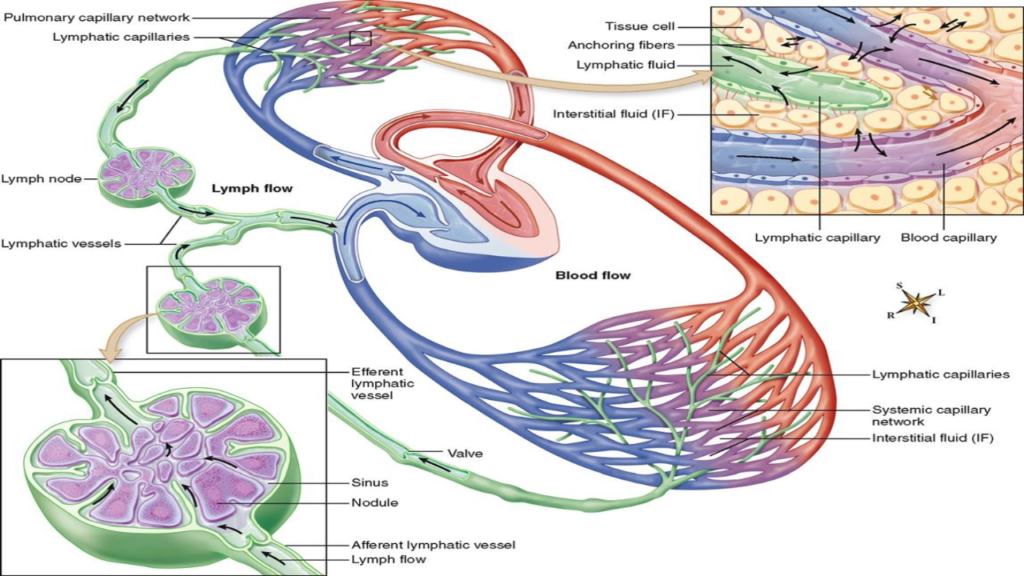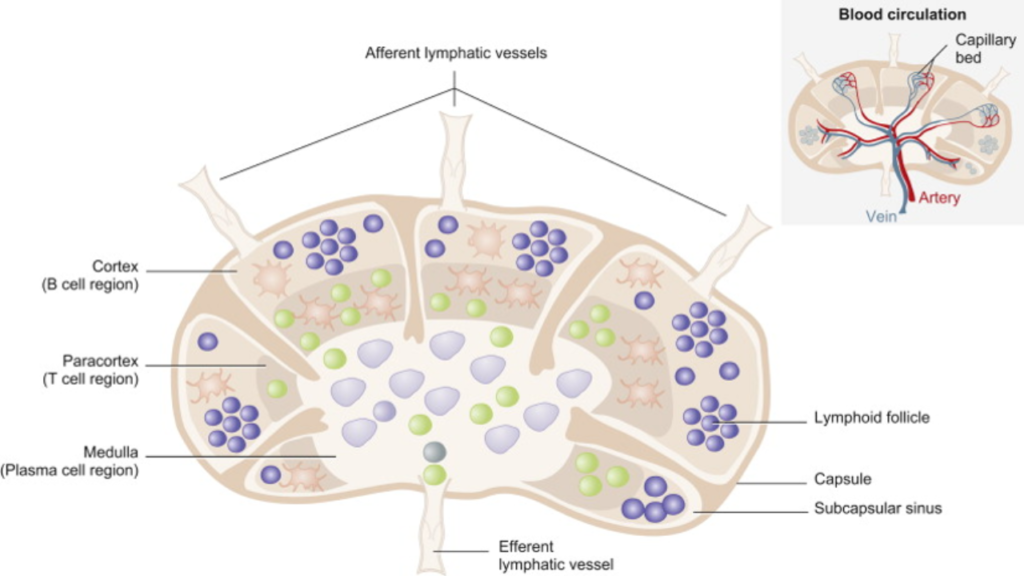Definition: The lymphatic system is a network of vessels, nodes, and organs in the body that helps fight infections, maintain fluid balance, and absorb fats from the digestive system.
It acts like a drainage system, collecting excess fluid from tissues and filtering out harmful substances to keep the body healthy.
Table of Contents
Functions of the Lymphatic System
1.Immune response: Lymph nodes filter lymph, activating immune cells to fight infections.
2.Fluid balance: Lymphatic vessels prevent swelling by collecting excess fluid from tissues.
3.Fat absorption: Lacteals in the small intestine absorb dietary fats and vitamins for digestion.
4.Transport: Immune cells and antibodies are transported throughout the body for immune surveillance.
5.Waste removal: Lymph nodes clear cellular waste and toxins, maintaining tissue health.
Components of the Lymphatic System
The lymphatic system is composed of several key components. Here are the main components of the lymphatic system:
1. Lymphatic Vessels:
•Lymphatic vessels are thin-walled tubes that parallel blood vessels throughout the body.
•They collect excess interstitial fluid, known as lymph, from the tissues and return it to the bloodstream.
•Lymphatic capillaries, the smallest vessels, absorb lymph from the tissue spaces.
2. Lymph Nodes:
•Lymph nodes are small, bean-shaped organs distributed along the lymphatic vessels.
•They act as filtration stations, where lymph is filtered to remove pathogens, foreign particles, and cellular debris.
•Lymph nodes contain immune cells, including lymphocytes (B cells and T cells), macrophages, and dendritic cells, which help mount immune responses against pathogens.

3. Lymphatic Organs:
I.Spleen: The spleen filters blood, removes old red blood cells, and aids in immune response initiation.
II.Thymus: The thymus matures and differentiates T lymphocytes, crucial for cellular immunity.
III.Lymph Nodes: Lymph nodes filter lymph, removing pathogens and activating immune responses.
IV.Lymphoid Tissues: Mucosa-associated lymphoid tissue (MALT) is specialized lymphoid tissue found in mucosal surfaces throughout the body.
4. Lymphatic Fluid (Lymph):
•Lymph is a clear, colorless fluid that flows through the lymphatic vessels.
•It contains water, proteins, electrolytes, fats, and white blood cells, including lymphocytes and macrophages.
5. Lymphoid Tissues:
•Lymphoid tissues are areas of concentrated lymphocytes and other immune cells found in various parts of the body.
•Mucosa-associated lymphoid tissue (MALT) is specialized lymphoid tissue found in mucosal surfaces throughout the body. Here are the main types of MALT:
I.Gut-associated lymphoid tissue (GALT): Found in the gastrointestinal tract.
II.Bronchus-associated lymphoid tissue (BALT): Located in the respiratory tract.
III.Nasopharynx-associated lymphoid tissue (NALT): Present in the nasopharynx.
IV.Genitourinary-associated lymphoid tissue (GUALT): Found in the genitourinary tract.
V.Conjunctiva-associated lymphoid tissue (CALT): Located in the conjunctiva of the eye.
6. Lymphatic System Supportive Structures:
i.Lacteals:
•Lacteals are specialized lymphatic vessels found in the small intestine.
•They absorb dietary fats and fat-soluble vitamins from the digestive tract and transport them into the lymphatic system.
ii.Cisterna Chyli:
•The cisterna chyli is a dilated sac-like structure located at the base of the thoracic duct in the abdomen.
•It serves as a storage tank for lymph collected from the lower body before it is transported into the bloodstream.
iii.Lymphatic Duct:
•These ducts are large vessels that return lymph to the bloodstream.
•Thoracic duct collects lymph from lower body, left upper body, and left head/neck.
•Right lymphatic duct collects lymph from upper right body.
iv.Valves:
•Valves are present within lymphatic vessels to prevent the backflow of lymph and ensure one-directional flow towards the bloodstream.
Lymphatic Circulation
1. Origination of Lymphatic Vessels:
•The journey of lymph begins in the interstitial spaces of tissues, where microscopic lymphatic capillaries originate.
•These capillaries are highly permeable and have specialized flap-like endothelial cells that allow them to collect excess fluid from the surrounding tissues.
2. Formation of Lymph:
•As the lymphatic capillaries collect fluid and waste, the interstitial fluid is transformed into lymph.
•Lymph is a clear, colorless fluid that closely resembles plasma but lacks red blood cells and has a lower protein content.
3. Transportation:
•Lymph moves through a network of lymphatic vessels, gradually increasing in size.
•Valves in lymphatic vessels prevent backward flow, ensuring one-way movement of lymph.
4. Filtration at Lymph Nodes:
•Along the lymphatic pathway, lymph passes through lymph nodes distributed throughout the body.
•Lymph nodes filter lymph, removing pathogens, cellular debris, and foreign particles.

5. Immune Surveillance:
•Immune cells within lymph nodes, such as lymphocytes and macrophages, monitor lymph for potential threats.
•Pathogens and other foreign substances captured by immune cells trigger immune responses to combat infections.
6. Drainage into the Central Lymphatic Ducts:
•After undergoing filtration and immune surveillance at the lymph nodes, lymph continues its journey through progressively larger lymphatic vessels.
•Eventually, the lymphatic vessels converge to form two main ducts: the thoracic duct and the right lymphatic duct.
•The thoracic duct, the larger of the two ducts, collects lymph from the lower body, left upper body, and left side of the head and neck.
•The right lymphatic duct drains lymph from the right upper body.
•These ducts ultimately empty into the bloodstream near the heart, specifically into the subclavian veins, where lymph is mixed with blood plasma and returned to circulation.
Diseases and Disorders of Lymphatic System
1. Lymphedema:
•Definition: Lymphedema occurs when the lymphatic system is impaired, leading to the accumulation of lymphatic fluid and subsequent swelling in the affected area.
•Types:
•Primary lymphedema: It may be congenital, meaning present at birth, and is often due to developmental abnormalities in the lymphatic system.
•Secondary lymphedema: It can develop later in life and is commonly caused by factors such as surgery (e.g., lymph node removal), radiation therapy, infections (e.g., filariasis), trauma, or cancer.
•Symptoms: Swelling, heaviness, tightness, and discomfort in the affected limb or area. The skin may also become thickened and prone to infections.
•Management: Treatment focuses on reducing swelling and managing symptoms through techniques such as manual lymphatic drainage, compression therapy, exercise, and skincare to prevent infections.
2. Lymphadenopathy:
•Definition: Lymphadenopathy refers to the enlargement or inflammation of lymph nodes, which can occur due to various underlying causes.
•Causes:
•Infections: Bacterial, viral, fungal, or parasitic infections can lead to the enlargement of lymph nodes, often as a result of the immune system’s response to the pathogens.
•Inflammation: Inflammatory conditions such as rheumatoid arthritis, lupus, or sarcoidosis can cause lymphadenopathy.
•Cancer: Lymphoma, leukemia, and metastatic cancer can infiltrate and enlarge lymph nodes.
•Symptoms: Enlarged, tender, or palpable lymph nodes, often accompanied by other symptoms depending on the underlying cause (e.g., fever, fatigue, weight loss).
•Diagnosis: Medical history, physical examination, imaging tests (e.g., ultrasound, CT scan), and sometimes biopsy of the affected lymph node may be required for diagnosis.
•Treatment: Treatment depends on the underlying cause and may include antibiotics for infections, anti-inflammatory medications for autoimmune conditions, or chemotherapy/radiation therapy for cancer-related lymphadenopathy.
3. Lymphoma:
•Definition: Lymphoma is a type of cancer that affects lymphocytes, the white blood cells responsible for the body’s immune response.
•Types:
•Hodgkin lymphoma: Characterized by the presence of Reed-Sternberg cells, a type of abnormal lymphocyte, in affected lymph nodes. It typically spreads in an orderly manner from one group of lymph nodes to another.
•Non-Hodgkin lymphoma: A diverse group of lymphomas that do not contain Reed-Sternberg cells. Non-Hodgkin lymphomas can arise from B cells, T cells, or natural killer (NK) cells and have a more varied clinical course than Hodgkin lymphoma.
•Symptoms: Enlarged lymph nodes, fever, night sweats, weight loss, fatigue, and other systemic symptoms depending on the extent of the disease.
•Diagnosis: Biopsy of an enlarged lymph node or other affected tissue is essential for diagnosing lymphoma. Additional tests such as blood tests, imaging studies (e.g., CT scan, PET scan), and bone marrow biopsy may be performed to determine the extent of the disease.
•Treatment: Treatment options for lymphoma may include chemotherapy, radiation therapy, immunotherapy, targeted therapy, or stem cell transplantation, depending on the type and stage of the disease.
4. Filariasis:
•Filariasis is a parasitic infection transmitted by mosquitoes that affects the lymphatic system.
•The parasites (Wuchereria bancrofti, Brugia malayi, or Brugia timori) infect the lymphatic vessels, causing lymphedema, elephantiasis, and hydrocele (fluid buildup in the scrotum).
5. Castleman Disease:
•Castleman disease is a rare disorder characterized by abnormal growth of lymphoid tissue, typically in the lymph nodes.
•It can be unicentric (affecting a single lymph node) or multicentric (involving multiple lymph nodes).
•Symptoms vary depending on the type and location of the disease and may include enlarged lymph nodes, fever, fatigue, and weight loss.
